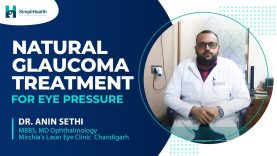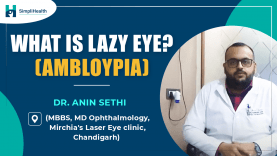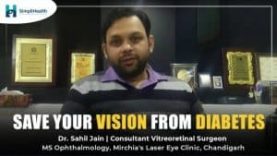Diabetic Retinopathy Stages & Types | रेटिनोपैथी से रेटिना(आँखो) पर प्रभाव? | How Diabetes Affects Your Eyes? | क्या रेटिनोपैथी ठीक हो सकती है? | रेटिनोपैथी का इलाज क्या है?
- 1.31K
- 4 years ago
Dr. Sahil Jain
Dr. Sahil Jain
Diabetic Retinopathy Stages & Types | मधुमेह आपकी आंखों को कैसे प्रभावित करता है? | शुगर में आंखों पर क्या प्रभाव पड़ता है? | क्या शुगर से आंखों की रोशनी कम हो जाती है?
Diabetic retinopathy stages & types, Let’s see eye-to-eye with these eye problems such as Diabetic Retinopathy under Ophthalmologist Dr. Sahil Jain’s guidance, Consultant vitreoretinal surgeon at the Laser eye clinic.
What is diabetic retinopathy?
Diabetes is one of the most dangerous diseases there are. It affects more than one part of the body. In this blog, we will elaborate on the effects of diabetes on the eyes.
How are diabetic Eye Diseases diagnosed?
Diabetes is a dangerous disease that affects multiple systems of the body. Commonly the kidney, brain, heart, and eyes. Diabetes affects the small blood vessels, including the defect in the eyes; this is called microvascular complications of diabetes.
What are the various eye problems caused by this?
Weakens eyesight | Diabetic Retinopathy Stages & Types
The lens’s water level increases called swelling of the lens. This could be treated by maintaining the patient’s body’s sugar level.
Cataract
Cataracts are commonly called Safed motia, could be another problem caused in a diabetic person. It is seen that patients with diabetes ofter suffer from black motia.
Diabetic retinopathy
It is the most harmful of all eye problems and can cause permanent blindness. Stating the three/four types of diabetic retinopathy, Dr. Sahil explains how diabetes affects your eyes and retina.
What are the two types of Diabetic Retinopathy?
Non-Proliferative Diabetic Retinopathy (NPDR)
In Layman’s terms, no new vessels are formed in this type, there is no bleeding in the eye, or neither there is no strain on the retina. It can vary from very mild variety to very severe type. The mild variety is the only dilatation of the small blood vessels.
Proliferative Diabetic Retinopathy (PDR)
New abnormal blood vessels are formed, putting a strain on the retina that is bleeding, ruptured, or uprooted. According to Dr. Sahil, over time, about half of people with diabetic retinopathy will develop Diabetic Macular Edema (DME). DME happens when blood vessels in the retina leak fluid, this leakage of fluid into the retina may lead to swelling of the surrounding tissue, including the macula. 99% of the vision is made from the macula area, but due to the swelling caused by the leakage of fluids and the cells can’t work proficiently in that area, causing blindness. DME is the most common cause of vision loss in people with diabetic retinopathy.
How can diabetic retinopathy be prevented? | Diabetic Retinopathy Stages & Types
If the patient has type 1 diabetes, i.e., your diabetes was diagnosed at an early age, and you are getting periodic insulin shots, then the patient needs to see an eye specialist within five years. For type 2 diabetic patients, i.e., the diagnosis of diabetes was diagnosed at the age of 30-40. These patients should contact and see an eye specialist as soon as possible.
Some patients often show symptoms and signs. On the other hand, patients whose disease could be diagnosed only by screening tests. Therefore, Dr. Sahil suggests getting periodic eye check-ups so that one can be aware of other grave diseases like diabetes. He further added that if the person is suffering from any eye-related problem or is experiencing loss of eyesight, he must see a doctor and thoroughly examine it because it may be possible that the patient has diabetes. It could be detected and treated through an eye check-up before it does any further damage.
Treatment for Diabetic Retinopathy:
Diabetic retinopathy has multiple treatments depending on the type. Dr. Sahil states that, If it is Non-Proliferative Diabetic Retinopathy and the patient only has macula edema, there are injections called Anti-vascular endothelial growth factors available for the treatment. He added, “Earlier and now, in few cases, we laser is used to treating or eliminating the damaged blood vessels. This laser treatment can cure this disease without any adverse effect and the patient may even retrieve his/her lost eyesight.”
Proliferative Diabetic Retinopathy (PDR) can be classified into two types, PDR being the first and Proliferative Diabetic Retinopathy with higher risk characteristics. According to Dr. Sahil, once the patient is diagnosed with PDR, he would have to get a laser treatment or injections that is for the doctor to decide.
Dr. Sahil suggests getting your diabetes treated alongside the loss of sight due to it. He adds the eye treatments would not work if the diabetes level is not controlled, so one should get his diabetes treated or in control under the guidance of a specialist who will suggest proper medications and maintain his sugar level. The second thing is to manage your lipids and fat in your bloodstreams; this would help treat the disease.
Lastly, he says that the last step would be treating eye problems. So if you have diabetes, you must get it checked and controlled and consult an eye specialist.











Comments (0)